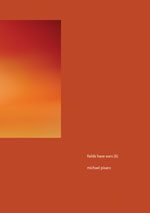|
|
 |
Dusted Reviews
Artist: Michael Pisaro Album: Fields Have Ears (6) Label: Gravity Wave Review date: May. 10, 2012 |

|
|
|
 |
Michael Pisaro walks with sure feet through the dark vale that I call the footnotification of art. One doesn’t have to spend much time in galleries, museums or performance spaces to run into work that not only requires extensive annotation in order for you to make sense of it, but also seems to locate most of its creativity in its explanation and/or justification.
Fields Have Ears (6) could be such a work. It is a 55:42-long composition constructed from sine waves, field recordings, and Pisaro’s electric guitar. He has written extensively, both in the CD’s liner notes and on his blog, about the ideas that form his Fields series (two others can be found on an earlier CD) and the process of this installment’s creation. On the face of things, you might expect a sound experience that gives prominent place to what sounds like random encounters on Chinatown streets and snatches of radio chatter in unidentified foreign languages to seem rather obscure, but on the contrary, I find that I keep forgetting the discussion when I listen to it, and not because the points are bogus or badly written (Pisaro’s actually a rather elegant wordsmith). Rather the individual elements, some quite prosaic, add up to generate an experience that is quite unparalleled, and not at all about words. So while I’d certainly encourage anyone who cares for the piece or the composer’s ideas to read what he has to say, I’d suggest listening first.
Like many Pisaro compositions, it opens with silence, and to silence it twice returns. The first sound he deploys is a sine wave, which fades into a sequence of outdoor sounds: water, wind, an airplane, trucks and horns. Then the sine tone returns; like silence, it clarifies and focuses whatever is in proximity to it. But he also uses sine tones as both augmenters and glue; they resonate with other sounds, adding richness without calling attention to themselves, and they also hold disparate components together, linking Pisaro’s moody guitar strums to the whoosh of distant traffic. If you resort to Pisaro’s annotation, you’ll have some idea why those field recordings are present; to represent where he was during successive performances of the piece, and also to create a literal field in which sounds don’t need to be linked, they can either simply or not so simply coexist. Pisaro’s fields have a lot of depth, which reward repeat listening; one time you might focus on a snatch of birdsong, another time on the passage of trucks, and another on the way a sine tone seems to bring another sound to a boil. They’re all happening around the same time, in the same vicinity, and the way they shift in relationship to each other puts a subtle shiver up the spine that doesn’t have a name. And you don’t need to know why Pisaro put them there to get that feeling.
By Bill Meyer
|







